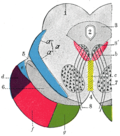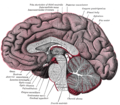| Cerebral aqueduct | |
|---|---|
 Section through superior colliculus showing path of oculomotor nerve. | |
 Drawing of a cast of the ventricular cavities, viewed from the side. | |
| Details | |
| Part of | Ventricular system |
| Identifiers | |
| Latin | aqueductus mesencephali (cerebri) aqueductus Sylvii |
| MeSH | D002535 |
| NeuroNames | 509 |
| NeuroLex ID | birnlex_1261 |
| TA98 | A14.1.06.501 |
| TA2 | 5910 |
| FMA | 78467 |
| Anatomical terms of neuroanatomy | |
The cerebral aqueduct (aqueduct of the midbrain, aqueduct of Sylvius, Sylvian aqueduct, mesencephalic duct) is a small, narrow tube connecting the third and fourth ventricles of the brain. [1] [2] The cerebral aqueduct is a midline structure that passes through the midbrain. It extends rostrocaudally through the entirety of the more posterior part of the midbrain. It is surrounded by the periaqueductal gray (central gray), a layer of gray matter. [3]
Contents
- Anatomy
- Relations
- Development
- Function
- Clinical significance
- History
- Additional images
- See also
- References
- External links
Congenital stenosis of the cerebral aqueduct is a cause of congenital hydrocephalus. [3]
It is named for Franciscus Sylvius.










